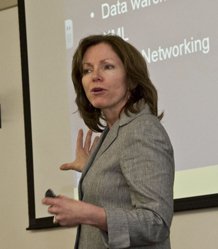CTG Director to States' Governors: Policy Innovation Needed to Leverage Technology Changes
Article by Theresa Pardo in 'Government Technology' Stresses Coordination with CIOs for Optimal Use of Information Systems
ALBANY, N.Y. (December 15, 2010) --
Elected officials in America increasingly see innovations in technology as keys to achieving their policy priorities, particularly in today’s difficult economic environment, but these officials often don't understand how they and their chief information officers must work together to reach their goals, says the director of UAlbany's Center for Technology in Government.
 |
CTG Director Theresa Pardo says state governors must work to have technology support policy change. (Photo by Mark Schmidt) |
"Elected officials are now turning to technology as part of their core strategy," says Theresa Pardo, CTG director and a research associate and professor in the Department of Public Administration & Policy and the College of Computing and Information. Writing in Government Technology, a leading trade magazine, Pardo credits chief information officers (CIOs) for "this new understanding of the relationship between technology innovation and achieving policy priorities . . . they've worked long and hard to ensure that the highest level leaders understand the potential technology has for transforming government."
Technologies alone, however, writes Pardo, are not enough to achieve such priorities as government consolidation, greater access to quality education, and enhanced economic development. The article outlines three "foundational capabilities" governors must invest in: governance, a culture of information stewardship, and public value assessment. The full article is available on the Governmental Technology website.
![]() For more news, subscribe to UAlbany's RSS headline feeds
For more news, subscribe to UAlbany's RSS headline feeds
Educationally and culturally, the University at Albany-SUNY puts "The World Within Reach" for its 18,000 students. An internationally recognized research university with 58 undergraduate majors and 128 graduate degree programs, UAlbany is a leader among all New York State colleges and universities in such diverse fields as public policy, nanotechnology and criminal justice. With a curriculum enhanced by 300 study-abroad opportunities, UAlbany launches great careers. For more information about this globally ranked University, visit https://www.albany.edu/. For UAlbany's extensive roster of faculty experts, visit www.albany.edu/news/experts.shtml.


